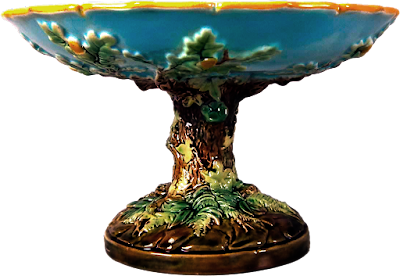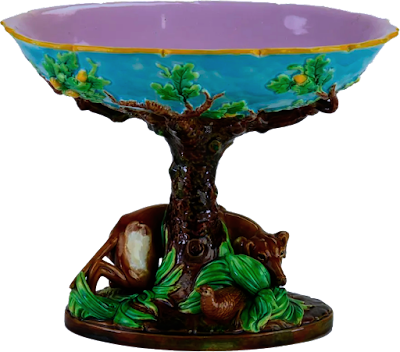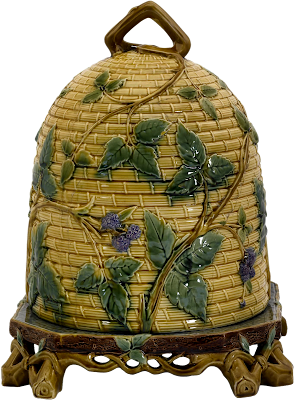The majolica reproduction market has been going strong for almost as long as I've been buying majolica. That would be around 35+ years. Some reproductions are excellent–difficult to distinguish from the antique originals. On the other hand there are those reproductions that are so incredibly bad that it's difficult to believe that anyone would be fooled by them. This post is about those reproductions.
Minton has always brought good prices in the antique market so it’s no surprise to see many fake pieces around. Sometimes these are marked MINTON in unusually large letters on the underside, something Minton NEVER did. The quality is uniformly horrendous. Minton is known for its detail and craftsmanship, qualities these reproductions lack. For example, look at the two reproductions below, followed by the Minton original.
Reproduction "Vintage" Flower Bearers
Reproduction "Vintage" Flower Bearers Minton Majolica Flower Bearers
One thing that all of these share in common is the awful craftsmanship of the work. Glazes are often dull or runny while modeling is usually so amateurish it's likely that the sculptor had never seen the real thing in person. Sections like interiors and undersides are often left unglazed. Some of these also show signs of artificial distress and crazing to give the impression of age.
Some of these reproductions are worse than others but they are all pretty terrible, certainly not worth the prices that some of them command on the antique market. I show the reproductions with the original posted below for comparison.
Reproduction flat iron teapot
Minton majolica flat iron teapot
The Minton rabbit centerpiece has apparently established its own little industry of reproductions as there are so many different ones available. There are even reproductions that replace the rabbits with monkeys, elephants or frogs.
Reproduction rabbit center
Reproduction rabbit center
Reproduction rabbit center
Minton majolica rabbit center
Minton lions head jardiniere reproduction
Minton majolica lions head jardiniere
Reproduction marine center
Minton majolica marine center
Reproduction monkey handled teapot
Minton majolica monkey handled teapot
Frog pitcher reproduction
Minton majolica frog pitcher
Modern cherub figure
Minton majolica cherub vase
Reproduction putti centerpiece
Minton majolica putti centerpiece
Reproduction bee skep cheese keeper
Minton majolica bee skep cheese keeper
Reproduction pineapple pitcher
Reproduction pineapple pitcher
Minton majolica pineapple pitcher
Reproduction dolphin compote
Minton majolica dolphin cream boat
Reproduction game terrine
Reproduction game terrine
Reproduction game terrine
Minton majolica hare and mallard game terrine
Reproduction putti handled jardiniere
Minton majolica putti handled jardiniere.
The Minton monkey holding a coconut teapot has inspired a number of reproductions, one worse than the next. First the original Minton piece followed by the copies.
Minton majolica monkey teapot
Reproduction monkey teapot
Reproduction monkey teapot
Reproduction monkey teapot
The Minton oyster plate is another that has fostered several reproductions. Some are good, most are bad. This doesn’t include companies like Fielding who copied the plate in the 19th century.
Reproduction oyster plate
Reproduction oyster plate
Fielding reproduction of a Minton plate
Minton majolica oyster plate
Reproduction putto riding dolphin vase
Minton majolica putto riding dolphin vase
Reproduction ram's head vase
Reproduction ram's head vase
Minton majolica ram's head vase
Reproduction dove bowl
Minton majolica dove center
Then there are those reproductions of designs made by other potteries that are spuriously marked MINTON.
Reproduction fish game dish
Reproduction with fake MINTON mark
George Jones majolica fish terrine
Reproduction cat compote. Note that the bowl is taken
from the reproduction bee skep cheese keeper
Reproduction false MINTON mark
Brownfield majolica cat box
These things are usually dumped into auctions where they cannot be returned. A reputable dealer will always give a refund on a piece falsely represented. Auctions are almost always final sales–buyer beware. Online these are usually listed as "vintage." That’s usually code for “brand new but meant to look like something old.” Occasionally they are listed as "mid-century" which is also absurd. There was no market for majolica reproductions in the 1950s-1960s. Most of these shown have been made in the past 10 years.
A knowledgable buyer would never be fooled by these, but that isn't the target audience for these pieces. It's usually either the general market dealer whose understanding of majolica is limited or those in the general public who aren’t familiar with the original pieces. These reproductions have limited value on the decorative market and no value in the antique market, so don't find yourself spending hundreds of dollars for something that originally sold wholesale for under $20.









































































